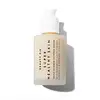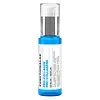What's inside
What's inside
 Key Ingredients
Key Ingredients

 Benefits
Benefits

 Concerns
Concerns

 Ingredients Side-by-side
Ingredients Side-by-side

Water
Skin ConditioningButylene Glycol
HumectantGlycerin
HumectantCoco-Caprylate/Caprate
EmollientDimethicone
EmollientC14-22 Alcohols
Emulsion StabilisingMicrocrystalline Cellulose
AbsorbentPolymethylsilsesquioxane
Phenoxyethanol
PreservativeGlyceryl Stearate
EmollientPEG-100 Stearate
Butyrospermum Parkii Butter
Skin ConditioningXanthan Gum
EmulsifyingC12-20 Alkyl Glucoside
EmulsifyingCellulose Gum
Emulsion StabilisingEthylhexylglycerin
Skin ConditioningChlorphenesin
AntimicrobialHelianthus Annuus Seed Oil
EmollientDisodium EDTA
Alcohol Denat.
AntimicrobialTerminalia Ferdinandiana Fruit Extract
AntioxidantCaramel
Cosmetic ColorantPEG-8
HumectantTocopherol
AntioxidantSodium Hydroxide
BufferingAscorbyl Palmitate
AntioxidantBeta-Carotene
Skin ConditioningDaucus Carota Sativa Root Extract
Skin ConditioningDaucus Carota Sativa Seed Oil
EmollientEchinacea Angustifolia Root Extract
Skin ConditioningRubus Idaeus Leaf Cell Culture
Skin ConditioningAscorbic Acid
AntioxidantCitric Acid
BufferingAcetyl Tetrapeptide-2
Skin ConditioningDextran
Water, Butylene Glycol, Glycerin, Coco-Caprylate/Caprate, Dimethicone, C14-22 Alcohols, Microcrystalline Cellulose, Polymethylsilsesquioxane, Phenoxyethanol, Glyceryl Stearate, PEG-100 Stearate, Butyrospermum Parkii Butter, Xanthan Gum, C12-20 Alkyl Glucoside, Cellulose Gum, Ethylhexylglycerin, Chlorphenesin, Helianthus Annuus Seed Oil, Disodium EDTA, Alcohol Denat., Terminalia Ferdinandiana Fruit Extract, Caramel, PEG-8, Tocopherol, Sodium Hydroxide, Ascorbyl Palmitate, Beta-Carotene, Daucus Carota Sativa Root Extract, Daucus Carota Sativa Seed Oil, Echinacea Angustifolia Root Extract, Rubus Idaeus Leaf Cell Culture, Ascorbic Acid, Citric Acid, Acetyl Tetrapeptide-2, Dextran
Water
Skin ConditioningGlycerin
HumectantVitis Vinifera Seed Oil
Emollient3-O-Ethyl Ascorbic Acid
Skin ConditioningShea Butter Ethyl Esters
EmollientGlyceryl Stearate
EmollientNeopentyl Glycol Diheptanoate
EmollientDicaprylyl Carbonate
EmollientPEG-100 Stearate
Isododecane
EmollientGlyceryl Dilaurate
EmollientHydrolyzed Plukenetia Volubilis Seed Extract
Emulsion StabilisingSteareth-21
CleansingTocopheryl Acetate
AntioxidantRosmarinus Officinalis Leaf Extract
AntimicrobialCichorium Intybus Root Extract
MaskingCopper Lysinate/Prolinate
Skin ConditioningMethylglucoside Phosphate
Skin ConditioningCaprooyl Phytosphingosine
Skin ConditioningCeramide NP
Skin ConditioningSodium Butyroyl Hyaluronate
HumectantSodium Hydroxide
BufferingButyrospermum Parkii Butter
Skin ConditioningCholesterol
EmollientCaprylyl Glycol
EmollientMagnesium Aluminum Silicate
AbsorbentCetyl Alcohol
EmollientEthylhexylglycerin
Skin ConditioningSteareth-2
EmulsifyingPEG-75 Stearate
Xanthan Gum
EmulsifyingAcrylates/Acrylamide Copolymer
MoisturisingPentaerythrityl Tetra-Di-T-Butyl Hydroxyhydrocinnamate
AntioxidantMicrocrystalline Cellulose
AbsorbentCeteth-20
CleansingSteareth-20
CleansingDisodium EDTA
Sorbic Acid
PreservativeCellulose Gum
Emulsion StabilisingParaffinum Liquidum
EmollientPolysorbate 85
EmulsifyingPhenoxyethanol
PreservativeWater, Glycerin, Vitis Vinifera Seed Oil, 3-O-Ethyl Ascorbic Acid, Shea Butter Ethyl Esters, Glyceryl Stearate, Neopentyl Glycol Diheptanoate, Dicaprylyl Carbonate, PEG-100 Stearate, Isododecane, Glyceryl Dilaurate, Hydrolyzed Plukenetia Volubilis Seed Extract, Steareth-21, Tocopheryl Acetate, Rosmarinus Officinalis Leaf Extract, Cichorium Intybus Root Extract, Copper Lysinate/Prolinate, Methylglucoside Phosphate, Caprooyl Phytosphingosine, Ceramide NP, Sodium Butyroyl Hyaluronate, Sodium Hydroxide, Butyrospermum Parkii Butter, Cholesterol, Caprylyl Glycol, Magnesium Aluminum Silicate, Cetyl Alcohol, Ethylhexylglycerin, Steareth-2, PEG-75 Stearate, Xanthan Gum, Acrylates/Acrylamide Copolymer, Pentaerythrityl Tetra-Di-T-Butyl Hydroxyhydrocinnamate, Microcrystalline Cellulose, Ceteth-20, Steareth-20, Disodium EDTA, Sorbic Acid, Cellulose Gum, Paraffinum Liquidum, Polysorbate 85, Phenoxyethanol
Ingredients Explained
These ingredients are found in both products.
Ingredients higher up in an ingredient list are typically present in a larger amount.
This ingredient is also known as shea butter. It is an effective skin hydrator and emollient.
Emollients help soothe and soften your skin. It does this by creating a protective film on your skin. This barrier helps trap moisture and keeps your skin hydrated. Emollients may be effective at treating dry or itchy skin.
Shea butter is rich in antioxidants. Antioxidants help fight free-radicals, or molecules that may harm the body. It is also full of fatty acids including stearic acid and linoleic acid. These acids help replenish the skin and keep skin moisturized.
While Shea Butter has an SPF rating of about 3-4, it is not a sunscreen replacement.
Shea butter may not be fungal acne safe. We recommend speaking with a professional if you have any concerns.
Learn more about Butyrospermum Parkii ButterCellulose Gum is a water-soluble polymer that comes from cellulose. It is used to change the texture of a product and to help stabilize emulsions.
As an emulsifier, cellulose gum specifically thicken the texture of water-based products.
This ingredient is considered hypoallergenic and non-toxic. Cellulose Gum can be found in cosmetics, food, and other household goods such as paper products.
Learn more about Cellulose GumDisodium EDTA plays a role in making products more stable by aiding other preservatives.
It is a chelating agent, meaning it neutralizes metal ions that may be found in a product.
Disodium EDTA is a salt of edetic acid and is found to be safe in cosmetic ingredients.
Learn more about Disodium EDTAEthylhexylglycerin (we can't pronounce this either) is commonly used as a preservative and skin softener. It is derived from glyceryl.
You might see Ethylhexylglycerin often paired with other preservatives such as phenoxyethanol. Ethylhexylglycerin has been found to increase the effectiveness of these other preservatives.
Glycerin is already naturally found in your skin. It helps moisturize and protect your skin.
A study from 2016 found glycerin to be more effective as a humectant than AHAs and hyaluronic acid.
As a humectant, it helps the skin stay hydrated by pulling moisture to your skin. The low molecular weight of glycerin allows it to pull moisture into the deeper layers of your skin.
Hydrated skin improves your skin barrier; Your skin barrier helps protect against irritants and bacteria.
Glycerin has also been found to have antimicrobial and antiviral properties. Due to these properties, glycerin is often used in wound and burn treatments.
In cosmetics, glycerin is usually derived from plants such as soybean or palm. However, it can also be sourced from animals, such as tallow or animal fat.
This ingredient is organic, colorless, odorless, and non-toxic.
Glycerin is the name for this ingredient in American English. British English uses Glycerol/Glycerine.
Learn more about GlycerinGlyceryl Stearate is a mix of glycerin and stearic acid.
It is used to stabilize the mixing of water and oil ingredients. By preventing these ingredients from separating, it can help elongate shelf life. It can also help thicken the product's texture.
As an emollient, it helps soften skin and supports barrier-replenishing ingredients.
In cosmetics, Glyceryl Stearate is often made from vegetable oils or synthetically produced.
This ingredient may not be fungal-acne safe
Fun fact: The human body also creates Glyceryl Stearate naturally.
Learn more about Glyceryl StearateMicrocrystalline Cellulose is another name for refined wood pulp. It is used as an emulsifier and mattifying ingredient. As an emulsifier, it helps keep ingredients together.
Peg-100 Stearate is an emollient and emulsifier. As an emollient, it helps keep skin soft by trapping moisture in. On the other hand, emulsifiers help prevent oil and water from separating in a product.
PEGS are a hydrophilic polyether compound . There are 100 ethylene oxide monomers in Peg-100 Stearate. Peg-100 Stearate is polyethylene glycol ester of stearic acid.
Phenoxyethanol is a preservative that has germicide, antimicrobial, and aromatic properties. Studies show that phenoxyethanol can prevent microbial growth. By itself, it has a scent that is similar to that of a rose.
It's often used in formulations along with Caprylyl Glycol to preserve the shelf life of products.
Sodium Hydroxide is also known as lye or caustic soda. It is used to adjust the pH of products; many ingredients require a specific pH to be effective.
In small amounts, sodium hydroxide is considered safe to use. However, large amounts may cause chemical burns due to its high alkaline.
Your skin has a natural pH and acid mantle. This acid mantle helps prevent harmful bacteria from breaking through. The acid mantle also helps keep your skin hydrated.
"Alkaline" refers to a high pH level. A low pH level would be considered acidic.
Learn more about Sodium HydroxideWater. It's the most common cosmetic ingredient of all. You'll usually see it at the top of ingredient lists, meaning that it makes up the largest part of the product.
So why is it so popular? Water most often acts as a solvent - this means that it helps dissolve other ingredients into the formulation.
You'll also recognize water as that liquid we all need to stay alive. If you see this, drink a glass of water. Stay hydrated!
Learn more about WaterXanthan gum is used as a stabilizer and thickener within cosmetic products. It helps give products a sticky, thick feeling - preventing them from being too runny.
On the technical side of things, xanthan gum is a polysaccharide - a combination consisting of multiple sugar molecules bonded together.
Xanthan gum is a pretty common and great ingredient. It is a natural, non-toxic, non-irritating ingredient that is also commonly used in food products.
Learn more about Xanthan Gum